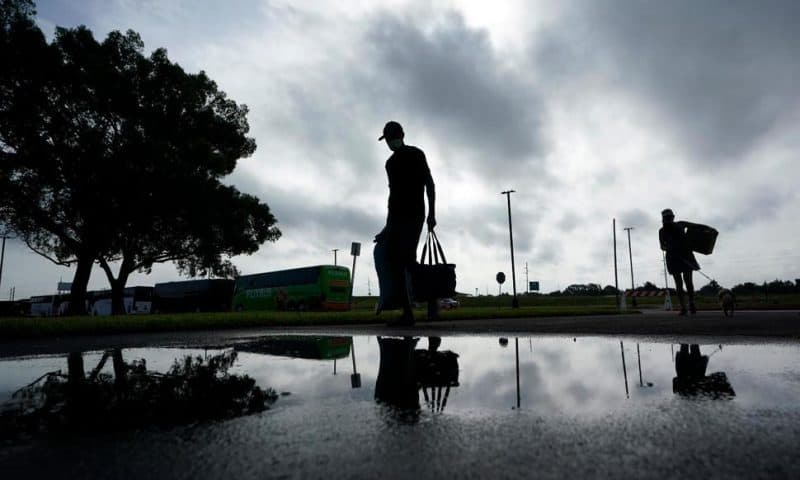The energy industry is bracing for catastrophic storm surges and winds as Hurricane Laura cuts a dangerous path toward the coastlines of Texas and Louisiana.
NEW YORK — The energy industry braced Wednesday for catastrophic storm surges and winds as Hurricane Laura cut a dangerous path toward the coastlines of Texas and Louisiana.
Oil and gas producers evacuated platforms and rigs in the Gulf of Mexico and companies were shutting down refineries in the storm’s path. Many had already done so while they were preparing for Tropical Storm Marco. Liquified natural gas facilities also were closing, and utilities braced for downed power lines and blackouts.
“These hurricanes, they can attack the entire energy infrastructure,” said Jim Burkhard, head of IHS Markit research for crude oil markets. “And it’s not just a refinery being shut down, but if a pipeline gets shut down, or the electrical grid gets damaged, it shows how integrated all these systems are: pipelines, refineries, electricity. And it’s that aggregate damage that can be so challenging to overcome.”
The oil industry was already hammered since the start of the year, struggling with low prices after the coronavirus decimated demand. At the same time, OPEC was flooding the market with crude, aiming — with success — to put American oil producers out of business.
Oil prices have recovered somewhat, but are still well below what most producers need to stay in business. Benchmark U.S. crude was selling for about $43 a barrel Wednesday, while gasoline was selling for about $2.20 a gallon, according to AAA. This year, 60 oil and gas companies filed for bankruptcy protection, according to law firm Haynes and Boone.
Experts say it’s unlikely that the U.S. will suffer from major oil or gasoline shortages due to the hurricane, as other regions fill in the gaps or turn to stored oil. But with higher demand that typically comes with summer, there could be some disruption.
“Inventories have been getting tighter through the summer,” said Peter McNally, global sector lead at Third Bridge, an investment research firm. “There is a buffer, but we still have a couple weeks left in the summer of higher demand, so we could see the surplus come off pretty quickly.”
OFF-SHORE PLATFORMS
Nearly half of the oil and gas platforms in the Gulf of Mexico — almost 300 — were evacuated by Wednesday, along with most of the offshore rigs. Producers shut in 84% of the oil produced in the region, taking about 1.6 million barrels per day off the market. The Gulf region usually produces about 15% of the oil in the U.S. Producers also shut in about 61% of the natural gas produced in the Gulf.
“Risk level is high,” said Stewart Glickman, energy equity analyst at CFRA, in an email. “Platforms out in the Gulf can be damaged, the refineries (mostly in low-lying land) can be flooded, especially if a storm lingers around for days like Hurricane Harvey did in 2017.”
While some oil production is temporarily suspended, experts say it’s unlikely to cause problems for supply in the U.S. There has been a surplus of oil production this year, and demand for fuel is still well below pre-pandemic levels. Producers outside the region can pick up the slack.
REFINERIES
More than half of U.S. refining capacity is built along the Gulf Coast, where the storm is heading. Six refineries, which together have a refining capacity of about 2.2 million barrels per day, were shut down, including refineries operated by Valero, Total and Citgo.
Refineries built in hurricane regions may have reinforced their facilities after prior hurricanes to withstand the storm, but it’s likely that there will be disruptions to some major refineries, Burkhard said.
In 2017, Hurricane Harvey stalled over Houston, dumping so much rain that flooding knocked out nearly a quarter of the nation’s refining capacity. That led to gasoline shortages, panic buying and long lines at service stations throughout Texas.
“Certainly for the local area that gets hit, it’s going to be disruption on all businesses, including gasoline sales,” Burkhard said. “Will this be as disruptive as Harvey? I don’t think we know yet, but Harvey was so damaging just because it lingered for so long, so let’s just hope this one doesn’t linger as long with severe flooding.”
LIQUIFIED NATURAL GAS PLANTS
Liquefied natural gas terminals in coastal Louisiana shut down ahead of Hurricane Laura’s arrival.
The 500 workers at Cheniere Energy Partners’ Sabine Pass LNG plant were told to follow local, state and federal instructions about storm preparedness and evacuation, said spokesman Eben Burnham-Snyder.
“We have secured the facility as best we can,” he said Wednesday.
Sempra Energy’s Cameron LNG, also in Cameron Parish, began shutting down Wednesday, according to an emailed statement.
“Cameron LNG is 18 miles inland from the Gulf of Mexico and designed to withstand a Category 5 Hurricane,” the statement said. It said a team of essential operations workers “will remain safely sequestered on site for any emergency.”

